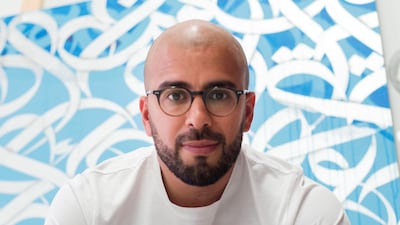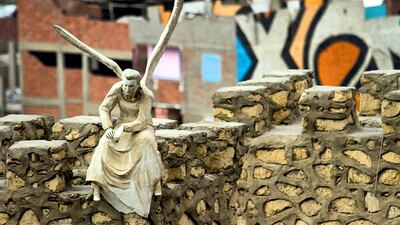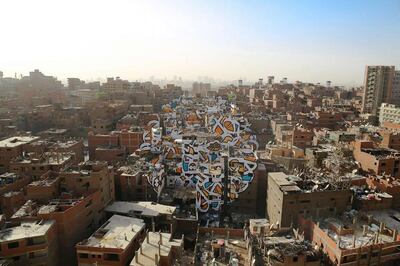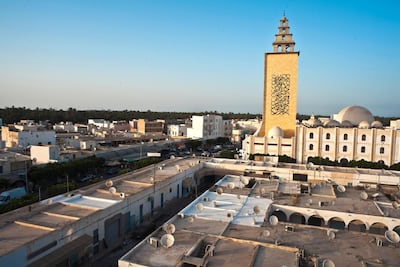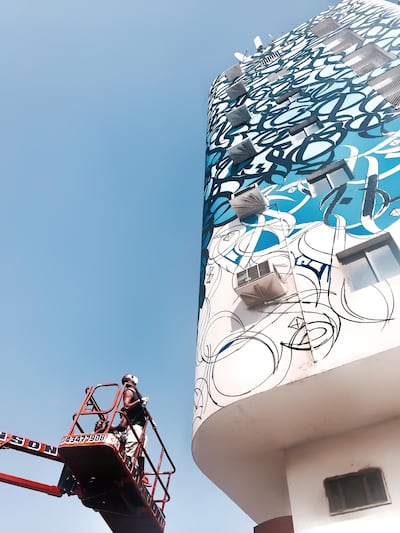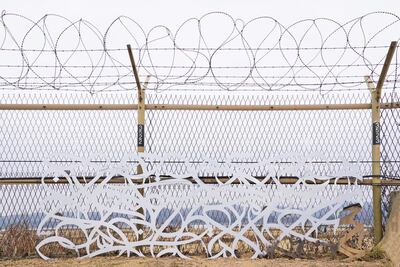Go into any cafe in Dubai, reel off names of contemporary artists to anyone willing to listen and their faces will often draw a blank. Mention French-Tunisian painter and sculptor eL Seed, however, and they will likely light up with admiring recognition.
Why? Because his galleries are the concrete walls, entire buildings, or even, as is the case with Cairo's Perception, the suburbs around us. Paint on canvas from a closed off studio, and your work will touch a rarefied few; but transform concrete in cities such as Ajman, Melbourne, Rio de Janeiro and Tunis, and you will speak to thousands.
"People are more connected to art in the public sphere," the unassuming 37-year-old Dubai resident, and former Parisian B-boy tells us. His work is described as "Calligraffiti" – he invariably writes in "decipherable" Arabic script, and picks a site-specific quote from a poet, author or public figure that he turns into street art.
The fact he works almost exclusively in Arabic script, but paints the words of thought leaders from across the world encapsulates, in many ways, his own experience as a Frenchman raised by Tunisian parents. "In France they sometimes make you feel like you need to choose [to be Arab or French], and today, people make you feel like you need to choose between being 'something' or 'something else', but actually, you can be a product of many layers," he says.
Despite acknowledging nuance here, the artist does think the region has a "je ne sais quois", beyond language, that unifies it. "If you're here in Dubai, or you go to Egypt, Lebanon or Tunisia, the way you say 'how are you?' is totally different … but then you can be anywhere in the Arab world and you'll feel like you've been there before. If you've been to Morocco, and you go to Egypt or Lebanon for the first time, you will feel something. There's a little spice that is exactly the same in every Arab country," he says.
"Arabic script has a universal beauty. It's cool to use a script that has so many stereotypes around it as a tool to bring people together. I think it's a way to give the script back its real value."
He feels privileged that people “allow” him to “paint on their houses”, and often finds himself “becoming part of their daily routine”, being invited into their homes for lunch, tea and dinner. “That’s what’s important for me with my art, the human experience, versus just painting in a studio.”
It's not all touching moments and tea parties, however. Many of eL Seed's projects require months, or years of planning, huge teams, cranes, lifts and crazy, around-the-clock schedules. He has a master's in supply chain management, and says his work "is all about logistics".
So, what's next for the prolific painter? Well, eL Seed tells us there are many places he'd love to work, "including Palestine," but that he is currently working on a public project in the GCC that is "scary because of the scale, the challenge and the shape of the thing we're painting".
Keep an eye on the structures around you, one of them is about to be transformed.
His latest collaboration
From street art to make-up, the artist has helped design the hues for a limited-edition range of lipsticks, a make-up palette, brushes and more with MAC cosmetics: the bright pink packaging of which is adorned with his script. He said he wanted to make sure the “blue, black and pink” common in his work was reflected in the collection, which it is – the full face palette features two shocking blues, one of which is named Porto Bleu (alluding to a town in Tunisia).
The bright red lipstick Maya is named after eL Seed’s daughter, the extra-dimension skinfinish highlighter is called Dima’s Glow (an homage to his wife) and the poppy pink shadow (or blush) in the palette is Gabriela – aka, Brazilian poet Gabriela Torres Barbosa, whose words he painted across a wall in a favela in Rio de Janeiro. The quote used on the packaging of this collection? “The face is a picture of the mind, with the eyes as interpreter.”
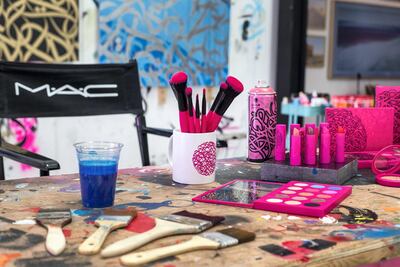
The brushes are particularly interesting – the handles are longer, and more like those of a painter, which Mariam Khairallah, who works as MAC’s global senior make-up artist out of Dubai, says allows those painting eyes to get a steadier, more definitive grip. “We have to keep these,” Khairallah jokes, pointing to the brushes, and referring to the fact the collection is limited edition. This collaboration was, phenomenally, four years in the making and eL Seed tells us he
is picky about who we works with. “There are other brands that I started collaborating with, but then I just stopped, because I didn’t feel comfortable: there was no story, or history of art in the brand. But MAC approached me more as a conversation, and the fact that they’ve already collaborated with many artists was important.”
The collection will be available at select MAC stores from Wednesday.
The stories behind the scripts
‘Perception’, Manshiyat Nasr, Cairo
Undoubtedly eL Seed’s most striking work, Perception is painted across about 50 buildings, and is only seen in all its glory from one particular point of the Mokattam Mountain. The words are from Saint Athanasius of Alexandria, a 3rd century Coptic Bishop: “Anyone who wants to see the sunlight, clearly needs to wipe his eyes first.”
The artwork’s title is not just about the quote used, however. It also connects with eL Seed’s motivation behind the work: the buildings are home to the Coptic community who are known as the “rubbish collectors of Cairo”. “I don’t have the arrogance to say I can change a neighbourhood, but I do have a responsibility to show the right face of a place,” eL Seed says.
“The people in this neighbourhood are called Zabaleen [rubbish people], but I think that’s sad, because when you actually speak to them you realise that isn’t their real name. My responsibility is to make sure people use their real name: Zerrab [which means pig breeders]. They aren’t ‘people of rubbish’ – they are people who clean, yes, but they have developed a powerful, natural recycling system, using their pigs to recycle organic waste.
“Sit in a fast food restaurant in Cairo, when people come in to collect rubbish, see how people react: they’re like ghosts – they come in, they go, nobody even sees them. But then you go to their neighbourhood you see how proud they are as people. To me, that’s important. We don’t change anything in people’s lives [through the artwork], but we may change how people perceive them.” The artist, who created this work over a year in 2016, stays in touch with the families he met while painting it. He even went back to the area for a wedding last November.
‘Madinati’, Jara Mosque, Gabes, Tunisia
In 2012, eL Seed painted the Quranic verse, “O mankind, indeed, We have created you from male and female and made you peoples and tribes so that you may know one another”, across the 57-metre minaret of the Jara Mosque in downtown Gabes. The minaret on the 1984 mosque had remained unadorned for 18 years, eL Seed says, “But when we approached the Imam he was really open, he said, ‘write whatever you want.’”
The chosen verse was, as the artist puts it, “a universal call for peace, tolerance and unity”. The political context at the time is key to the work, which appeared in the southern coastal city just a year after Tunisia’s tense revolution. “It was important to me that this work was a call for unity,” eL Seed says. “People connected because of it, if you hang something 50-metres-high in the middle of a city, you will of course see people talking and engaging in conversation, and people who normally don’t speak with each other will talk. That’s the power of art.”
‘Les Yeux Dan Les Bleus’, Al Bustan Building, Ajman, UAE
“This is one of my favourite works – I like the fact that I didn’t paint the white of the buidling,” eL Seed says. And while it wasn’t one of his most logistically difficult in terms of scale or shape, it was a challenge when it came to timing: “I painted it during Ramadan, so it was super-difficult. I tried before iftar, after iftar, early in the morning before suhoor … but then I just decided to pause, and start again after Ramadan.”
The fact that it was a fairly unassuming apartment block appealed to eL Seed. “It was great because it was residential, so you connect with people in the windows, and Ajman has a very different feeling to Dubai [where his open studio is].” The script reveals a poem by Sheikh Zayed, the Founding Father, which implores people to preserve the land for the next generation.
‘The Bridge’, DMZ between North and South Korea
This work is a laser-cut aluminium representation of a poem by Kim Sowol, a poet from the land that is now North Korea, but who died before the peninsula was divided. “Giving importance to other people’s work is for me, a sense of duty,” eL Seed says, explaining why he highlighted this piece of poetry, which tackles the fragmented nature of memory.
While the artist says he doesn’t believe that street artists are the “rock stars” of the art world, he did have a glimpse of star treatment when he travelled to Seoul to start on this logistically tricky work, which required many permissions and compromises. “I did a workshop with kids from an underprivileged neighbourhood of Seoul, and I got the feeling of what it would be like to be Justin Bieber, just for a second,” he says. “I thought there would be like 20 people, and then I entered the gymnasium and there were about 100 kids, and a guy with a mic like in the movies.”
